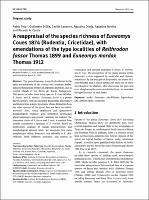A reappraisal of the species richness of Euneomys Coues 1874 (Rodentia, Cricetidae), with emendations of the type localities of Reithrodon fossor Thomas 1899 and Euneomys mordax Thomas 1912
Date
2021-03-15Author
Teta, Pablo Vicente
D’ Elía, Guillermo
Lanzone, Cecilia
Ojeda, Agustina Alejandra
Novillo, Agustina
Ojeda, Alejandro Alberto
Metadata
Show full item recordAbstract
The genus Euneomys is mostly distributed in the open environments of the central and southern Andes, adjacent Patagonian steppes of Argentina and Chile, and in
several islands of the Tierra del Fuego Archipelago. This genus includes three living species: E. chinchilloides, E. fossor, and E. mordax. Euneomys fossor is a poorly known species, with an uncertain geographic provenance and known from a single specimen, whose distinction from the other species of the genus has not been accurately assessed. Here, using qualitative and quantitative morphological evidence, plus published information about karyotypes and genetic variation, we evaluate the taxonomic status of E. fossor and E. noei, a nominal form usually considered a synonym of E. mordax. Based on multivariate analysis of cranial measurements and morphological discrete traits, we recognize two main morphotypes within Euneomys, one referable to E. chinchilloides (with dabbenei, petersoni, and ultimus as synonyms), and another including E. fossor, E. mordax,
and E. noei. The recognition of two major groups within Euneomys is also supported by molecular and chromosomal data. By the principle of the priority, the names of E. chinchilloides and E. fossor applies for each one of these
morphotypes. In addition, after discussing the pros and cons of replacing the name mordax by fossor, we emended the type localities of both forms.
Collections
The following license files are associated with this item:



